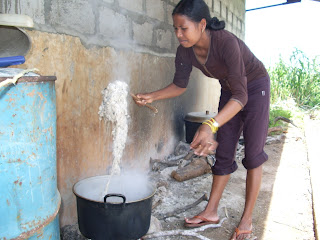Every district of Timor Leste has its own "tais" pattern. These textiles are still made by hand and are used for several different purposes. Traditionally, they are worn in the same way as a sarong. But nowadays, some of the handicraft shops are branching out to make all kinds of things with tais - everything from laptop bags to picture frames to book covers. They also make great cushion covers, bedspreads, and tablecloths. Dili has a tais market where you can see the range of beautiful colours and designs that are available.
Tais is woven cloth that is worn in Timor-Leste and forms an important part of ceremonial occasions such as births, weddings and funerals. Tais weaving is considered to be women’s work and this skill was traditionally considered a prerequisite for marriage. Mothers would teach their daughters the techniques and patterns depicting cultural beliefs and stories. In recent years the selendang, a scarf-like tais cloth which is placed ceremoniously around the neck to pay tribute, has become common.
Tais production
Tais is traditionally made from locally harvested cotton that is hand-spun, dyed using natural dyes from leaves, bark and fruit rinds, and woven with unique patterns. Skilled weavers produce intricate designs and are highly valued in their communities. Each step takes days to complete, with complex pieces taking more than a year.As women are very involved in producing food and caring for children, finding time for weaving can be difficult. During the Indonesian occupation (1975–99), it became common for commercially produced threads and dyes from Indonesia to be used in the production of tais, although most people considered them an expensive luxury. Only recently have tais been produced for sale, mainly to Westerners, as an extra source of income.
Silk tais production
Shortly after Timor-Leste’s independence in 1999, Father Pat MacAnally worked with AusAID and the Catholic Relief Services to set up a sericulture (silk production) project in Triloka in the Baucau district.

The project aimed to use the traditional knowledge of farming and tais production in new ways to help villagers become self-sufficient. Farmers grow mulberry trees for their leaves to feed silkworms, whose silk is spun and woven into tais. Sales of the silkworms, silk and tais generate a higher income than cotton tais.Initially, the village chiefs nominated people to work on mulberry farms – mostly widows or young men without skills. The land was prepared for planting, hatching sheds were built, and the trees and silkworms were imported from Indonesia. For each day’s work, employees received three kilos of rice, supplied by the UN World Food Programme and funded by Catholic Relief Services.
Called Loron Aban Hahu Ohin (LAHO), or ‘The Future Starts Today’, the project has continued growing. Each farmer produces about 20 kilograms of cocoons per cycle, with about six cycles each year. As the mulberry trees develop, the number of silkworm caterpillars they can raise will increase. Surplus land in each village has been used to cultivate more trees. It is anticipated that each farmer will earn around US$700 per year from the silkworms. There are hopes that in the future silkworm eggs can be produced locally rather than importing them.
The raw silk is spun and woven on a back-strap loom into tais and sold by the village women. Younger women learn hand-spinning practices from their elders, ensuring that this knowledge is not lost.
Since 2002, 23 hectares of mulberry trees have been cultivated, and 19 local farming groups (made up of approximately 75 individual farmers), have been assisted with both material and technical support. Silk production has given women and men the opportunity to develop the skills required for the manufacture of marketable silk products and to become self-sufficient.




0 comments:
Fo Ita Nia Mensagem
Fo Hatene Mai Ami konaba Ita Nia Hanoin....!!!!!(By: | Fo'o Viegas |)